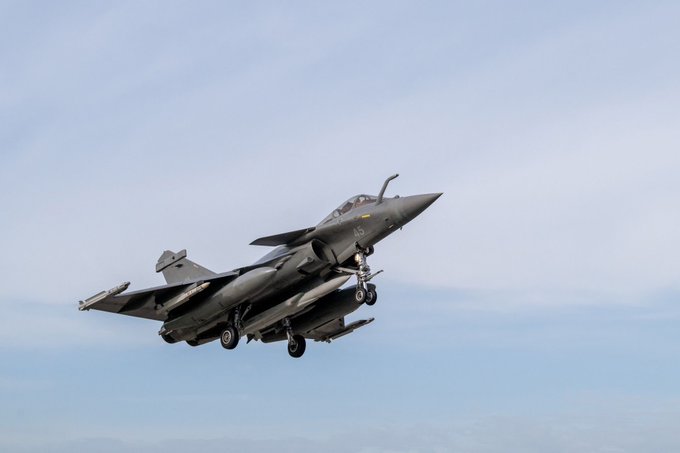At a time when the international security situation is characterised by permanent competition between states to guarantee their access to exo-atmospheric space, the growth in the space industry offers great opportunities. The Integrated Review and the Defence Command Paper give the necessary backing to the Own, Collaborate and Access framework, which will enable the United Kingdom to seize them.
Using the Own, Collaborate, Access Framework to Enable the Defence Space Portfolio
Introduction
Space, once ‘approached as a sanctuary and non-warfighting domain’(1) has been a key enabler of the Western way of warfare for over 30 years underpinning harmony to deliver operational success;(2) however, it is increasingly seen as an operational or warfighting domain by states and international organisations. This change in the approach to space negates traditional thinking. With ‘space is vital to the UK’s security and resilience’(3) the requirement for cogent space power thinking, innovation and development of capabilities for space as an operational domain is critical to ensuring that the UK can meet the National Space Strategy Goal 4 (Protect our national interests in and through space);(4) before you can effectively develop and employ space power you must understand its essence.
Space enables multidomain integration and as we have seen from the Ukraine conflict, space is able to underpin decision advantage, ensuring operational decisions can be made at the speed of relevance. According to UK MoD, the characteristics of space power, persistence, access, and perspective(5) enable space capabilities to support multiple operations across the globe simultaneously, for example a geosynchronous communications satellite can enable can support communications for multiple operations within its field of view.
The international security context is characterised by persistent, aggressive state competition with capabilities that threaten our access to space. Russia, China and India have all conducted tests of anti-satellite missiles. Russia has developed complex electronic warfare systems that can jam satellite signals such as Global Navigation Satellite Systems and satellite communications, used novel methods to conduct sophisticated, on-orbit activities and threaten on-orbit capabilities using missile interceptors.(6) Cyber threats, both state and non-state based, have the potential to deny, disrupt or deceive satellite data, and the increasingly pervasive nature of both military and commercial Space-based Intelligence, Surveillance and Reconnaissance (ISR) is increasingly affecting the conduct of military operations.
The growth of the Space industry and the acceleration of technology within the space domain offers opportunities for rapid innovation within Defence to integrate space across the spectrum of Defence’s activity including operational planning, doctrine, capability development and training. To keep pace with the technological change being driven by industry and capitalise on the dual use capability applications that space presents, Defence needs new, agile acquisition processes, increased experimentation, and the ability to evolve cutting edge operational demonstrators into fast-paced capability programmes. To meet future security challenges, Defence needs to aim for a timeline from design to on-orbit in months.
New Space
Since 2010, New Space has been used to describe modern commercial space activity. New Space can be described as “a global industry of private companies and entrepreneurs who primarily target commercial customers, are backed by risk capital seeking a return, and seek to profit from innovative products or services developed in or for space”.(7) New Space exists because of the broadening commercial market for space technology, which, particularly in the US, has triggered significant investment in small fast-moving, start-up style businesses which seek to disrupt the established order of aerospace companies offering services in and from space.(8) The key difference between the traditional space and New Space companies until recently is their customer base. Traditional primes focus on state customers and New Space on commercial customers. Whilst for the foreseeable future the state will remain coupled to the space economy, as the state must make the domain “accessible in legal, technical and economic ways”(9) through regulation and investment, this provides Defence with an opportunity to increase the speed of its’ capability development by utilising New Space’s rapid development of technology and government funding in the space sector.
Policy enablement
The Integrated Review 21(10) committed the UK to be a ‘meaningful actor in space’ with an integrated civil and military space policy but also to take a more active approach to building and sustaining strategic advantage through science and technology. The Defence Command Paper went further focusing on Research and Development in space to accelerate the development and adoption of new technologies(11) to meet the national ambition of being ‘a meaningful actor in space’ and underpin the UK space commercial sector. The National Space Strategy(12) and the subsequent Defence Space Strategy(13) developed the concepts and ideas outlined in the Integrated Review and Defence Command Paper into actionable concepts to deliver space activities out to 2030.
Integration is key to success in modern warfare, and space is a key enabler in integrating the joint force. The Defence Space Strategy highlights as a key tenet the fundamental importance of integration to deliver the national ambition, between domains, government, partners and allies, industry, and academia. Complimentary to integration is resilience and the UK aim to ensure that it collaborates with Allies to provide the resilience and complementary capabilities to enable a safe and secure space domain. Integration and resilience of the space domain will support deterrence, enhance resources, and enable mission assurance.(14) The Defence Space Strategy outlines three strategic themes to deliver the national ambition. First is Protect and Defend, which focuses on the development of capabilities and processes to enable the UK to protect and defend its national interests in and through space. Second is Enhance Military Operations which enables the integration of space and provision of assured space services into all aspects of UK Defence. Finally, Upskill and Cohere focuses on developing the UK Defence space workforce including how to recruit, train and retain space professionals in Defence. These three themes along with the key tenets of integration and resilience enable the UK capability management priorities for the Defence Space Portfolio which enhance the UK’s ability to understand, decide and act. The capability priorities balance the need for space support to the joint force as well as the need to provide capabilities to support space as an operational domain.
Learning lessons from capability development in other domains, and in particular the Air and Cyber domains, is vital to enabling rapid innovation and capability development in space, there must be a recognition that space is different and must adapt acquisition processes accordingly. Reviewing how partners and allies enable their capability development can generate an understanding of best practices which enable the ability to conduct rapid innovation to deliver capability.(15) Ultimately, however, there are attributes of space that require unique considerations and trade-offs, such as payload or fuel, to be made when developing, acquiring, or operating and supporting capability in this domain,(16) especially when you consider the baseline and finite resource available. The UK “cannot simply replicate the approaches of larger or more established space powers such as the United States or even France”.(17) Therefore, innovation both in capability and process is required to deliver space capability and the UK has developed the ‘Own, Collaborate and Access’ framework.
Own, Collaborate or Access
Assured access to Space and associated industrial capability is vital to operational independence and to protect the sensitive technologies.(18) Own, Collaborate or Access(19) framework sets out criteria against which “technologies and services will be identified, developed and generated depending on the level of ownership and control required”(20) which will impact the speed at which those capabilities are developed. Below the simply articulated ‘own, collaborate or access’ framework is a complex set of criteria that leads to a multitude of combinations and methods of engagement with industry partners and Allies, each having different benefits, costs, and risks.
Space is, compared to the traditional domains, significantly less platform centric and focused on a system of systems approach. Individual spacecraft are, by their nature, part of a wider system (space, link, and ground segments) and integrated into that system to deliver their mission and often multiple missions are onboard a single satellite. The system of systems nature of space capability is complex with multiple different systems, activities and actors involved, especially when considering upstream activities such as design, manufacture, and launch. Building a resilient industrial base which has a mix of primes and agile start-ups coupled with the agile processes and procurement structures to ensure that Defence can access the technological advances of New Space at the speed of relevance is complex and will need support from Defence. Therefore, space capability choices are likely to contain a blend of options across the holistic system of systems to meet the Defence requirements.
Defence can identify through its requirements those options which could be considered to lie at the extremes of the framework, such as those options which Defence must own, due to the requirement for sovereign ownership of the capability for operational effectiveness. Additionally, Defence must think critically about those capabilities that can be accessed through commercial solutions. Whilst the Ukraine conflict has highlighted the criticality of space to modern warfare, it also has highlighted the value of commercial technologies. Ukraine has successfully employed use of commercial satellite systems to access near real-time ISR, space-based internet services, and Position Navigation and Timing solutions. These capabilities, and the unclassified nature of the products, have also helped to counter the Russia’s authoritarian disinformation campaign on the global stage. Therefore, Defence needs to toughly scrutinise its information requirements to understand exactly the blend of sovereign, allied and commercial data required.
Whilst the extremities of the framework are somewhat easier to rationalise for capability programmes, those that fall into the middle of the framework and have the ability to be a blend of options require an understanding of the balance of investment considering:
• affordability and value for money,
• operational and decision advantage,
• supply chain security,
• interoperability with partners and Allies,
• international engagement,
• prosperity agenda,
• innovation and generation of Intellectual Property,
• risks and timeline for fielding the capability.(21)
Each programme balance of investment will bring benefits and disbenefits which will need to be balanced over the whole space portfolio to ensure that the strategic objectives are achieved whilst still moving at a pace that enables capability procurement to be able to capitalise on technological innovation. Portfolio management with the overarching view, is key to ensure that the blend of programmes and their dependencies, benefits and risks is balanced to ensure a sustainable level of risk and opportunity through innovation within the portfolio. ♦
(1) McCall Stephen M., Space as a Warfighting Domain: Issues for Congress, Congressional Research Service, 10 August 2021 (https://sgp.fas.org/crs/natsec/IF11895.pdf).
(2) Burt Kelly D. (Maj.), Space Power In Small Wars: The End of Asymmetric Advantage?. School of Advanced Air and Space Studies, Air University, June 2010, p3 (https://www.hsdl.org/?view&did=816832).
(3) HM Government, National Space Strategy. September 2021, p10 (https://assets.publishing.service.gov.uk/).
(4) Ibid. p20.
(5) HM Government, Defence Space Strategy: Operationalising the Space Domain. London: HNG, February 2022, p18.
(6) Wright Timothy, ‘Russia tests Space Based Anti-Satellite Weapon’, IISS, 9 September 2020. (https://www.iiss.org/).
(7) Weinzierl Matthew and Acocella Angela, ‘Blue Origin, NASA, and New Space (A)’, Harvard Business School Case 716-012, February 2016 (Revised May 2016), p1.
(8) Madry Scott, Disruptive Space Technologies and Innovations: The Next Chapter, Springer, 2019, 252 pages.
(9) Shammas Victor Lund and Holen Tomas B., ‘One Giant Leap for Capitalistkind: Private Enterprise in Outer Space’, Palgrave Communications, 2019, p6.
(10) Strachan Hew, ‘Global Britain in a Competitive Age: Strategy and the Integrated Review’, Journal of the British Academy, No 9, p. 161-177. https://doi.org/10.5871/jba/009.161.
(11) Defence Command Paper, p45. https://assets.publishing.service.gov.uk/.
(12) HM Government, National Space Strategy, op. cit.
(13) HM Government, Defence Space Strategy, op. cit., p18.
(14) Ibid., p16.
(15) Retter Lucia, Black James, and Ogden Theodora, ‘Realising the Ambitions of the UK’s Defence Space Strategy: Factors Shaping Implementation to 2030’. Santa Monica, CA: RAND Corporation, 2022. (https://www.rand.org/pubs/research_reports/RRA1186-1.html).
(16) Ibid.
(17) Ibid.
(18) HM Government, Defence and Security Industrial Strategy: A Strategic Approach to the UK’s Defence and Security Industrial Sectors, March 2021 (https://assets.publishing.service.gov.uk/).
(19) Defence Space Strategy, p18: Own. Where the UK has leadership and ownership of new developments, from discovery to large-scale manufacture and commercialisation. This will always involve elements of collaboration and access. Collaborate. Where the UK can provide unique contributions that allow us to collaborate with others to achieve our goals. Access. Where the UK will seek to acquire critical science and technology from elsewhere, through options, deals and relationships. This will always be conducted within the bounds of the MOD’s Assured Capability Framework, cognisant of the fact that there will be differing national levels of assured access requirements.
(20) Ibid.
(21) Retter Lucia, Black James, and Ogden Theodora, op. cit., p58.









